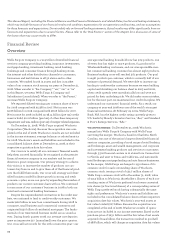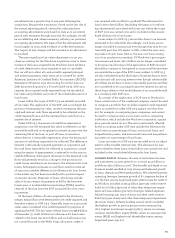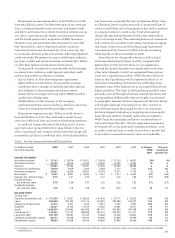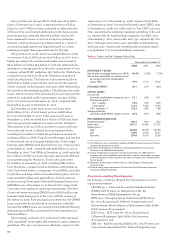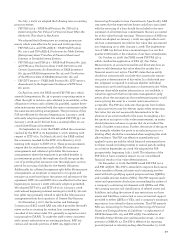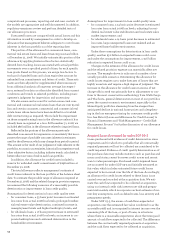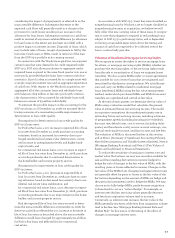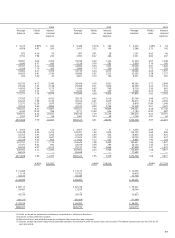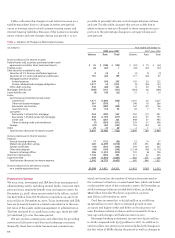Wells Fargo 2008 Annual Report Download - page 44
Download and view the complete annual report
Please find page 44 of the 2008 Wells Fargo annual report below. You can navigate through the pages in the report by either clicking on the pages listed below, or by using the keyword search tool below to find specific information within the annual report.computational processes, reporting and end-user controls of
the models are appropriate and well documented. In addition,
regulatory examiners review and perform detailed tests of
our allowance processes.
Forecasted losses are compared with actual losses and this
information is used by management in order to develop an
allowance that management believes adequate to cover losses
inherent in the loan portfolio as of the reporting date.
The portion of the allowance for commercial loans, com-
mercial real estate loans and lease financing was $4.5 billion
at December 31, 2008. We initially estimate this portion of the
allowance by applying historical loss factors statistically
derived from tracking losses associated with actual portfolio
movements over a specified period of time, for each specific
loan grade. Based on this process, we assign loss factors to
each pool of graded loans and a loan equivalent amount for
unfunded loan commitments and letters of credit. These esti-
mates are then adjusted or supplemented where necessary
from additional analysis of long-term average loss experi-
ence, external loss data or other risks identified from current
conditions and trends in selected portfolios, including man-
agement’s judgment for imprecision and uncertainty.
We also assess and account for certain nonaccrual com-
mercial and commercial real estate loans that are over $5 mil-
lion and certain consumer, commercial and commercial real
estate loans whose terms have been modified in a troubled
debt restructuring as impaired. We include the impairment
on these nonperforming loans in the allowance unless it has
already been recognized as a loss. At December 31, 2008, we
included $816 million in the allowance related to impaired loans.
Reflected in the portions of the allowance previously
described is an amount for imprecision or uncertainty that incor-
porates the range of probable outcomes inherent in estimates
used for the allowance, which may change from period to period.
This amount is the result of our judgment of risks inherent in the
portfolios, economic uncertainties, historical loss experience and
other subjective factors, including industry trends, calculated to
better reflect our view of risk in each loan portfolio.
In addition, the allowance for credit losses included a
reserve for unfunded credit commitments of $698 million at
December 31, 2008.
The total allowance reflects management’s estimate of
credit losses inherent in the loan portfolio at the balance sheet
date. To estimate the possible range of allowance required at
December 31, 2008, and the related change in provision expense,
we assumed the following scenarios of a reasonably possible
deterioration or improvement in loan credit quality.
Assumptions for deterioration in loan credit quality were:
• for consumer loans, a 55 basis point increase in estimated
loss rates from actual 2008 loss levels, prolonged residen-
tial real estate value deterioration, continued increase in
unemployment levels and higher bankruptcy levels; and
• for wholesale loans, a 17 basis point increase in estimated
loss rates from actual 2008 loss levels, an increase in cor-
porate bankruptcies and continued deterioration in the
homebuilder environment.
Assumptions for improvement in loan credit quality were:
• for consumer loans, a 24 basis point decrease in estimated
loss rates from actual 2008 loss levels, adjusting for resi-
dential real estate value stabilization and real estate sales
market improvement; and
• for wholesale loans, a 14 basis point decrease in estimated
loss rates, large unexpected losses not realized and an
improved home builder environment.
Under these assumptions for deterioration in loan credit
quality, another $3.2 billion in expected losses could occur
and under the assumptions for improvement, a $1.6 billion
reduction in expected losses could occur.
Changes in the estimate of the allowance for credit losses
and the related provision expense can materially affect net
income. The example above is only one of a number of rea-
sonably possible scenarios. Determining the allowance for
credit losses requires us to make forecasts of losses that are
highly uncertain and require a high degree of judgment. The
increase in the allowance for credit losses in excess of net
charge-offs in 2008 was primarily due to adjustments to con-
form to the most conservative methodology from Wells Fargo
and Wachovia, general deterioration in most of our portfolios
given the current economic environment, especially in the
Home Equity portfolios stemming from the steeper than
anticipated decline in national home prices and a lengthen-
ing in the loss emergence timing for consumer credit portfo-
lios. See Note 6 (Loans and Allowance for Credit Losses) to
Financial Statements and “Risk Management – Credit Risk
Management Process” for further discussion of our allowance
for credit losses.
Acquired Loans Accounted for under SOP -
Loans purchased with evidence of credit deterioration since
origination and for which it is probable that all contractually
required payments will not be collected are considered to be
credit impaired. Evidence of credit quality deterioration as of
the purchase date may include statistics such as past due and
nonaccrual status, recent borrower credit scores and recent
loan to value percentages. Purchased credit-impaired loans
are accounted for under SOP 03-3 and initially measured at
fair value, which includes estimated future credit losses
expected to be incurred over the life of the loan. Accordingly,
an allowance for credit losses related to these loans is not
carried over and recorded at the acquisition date. We esti-
mate the cash flows expected to be collected at acquisition
using our internal credit risk, interest rate risk and prepay-
ment risk models, which incorporate our best estimate of cur-
rent key assumptions, such as default rates, loss severity and
prepayment speeds.
Under SOP 03-3, the excess of cash flows expected at
acquisition over the estimated fair value is referred to as the
accretable yield and is recognized in interest income over the
remaining life of the loan, or pool of loans, in situations
where there is a reasonable expectation about the timing and
amount of cash flows expected to be collected. The difference
between the contractually required payments at acquisition
and the cash flows expected to be collected at acquisition,




